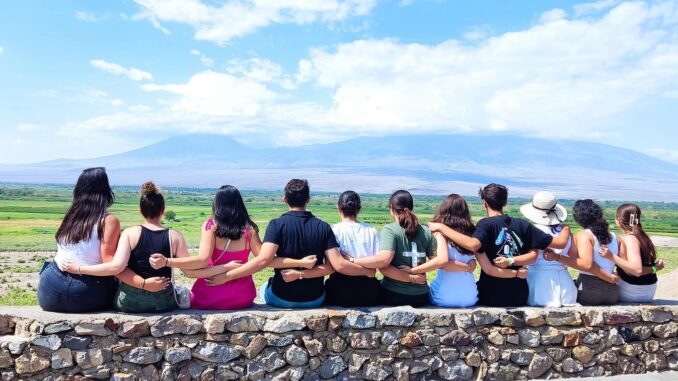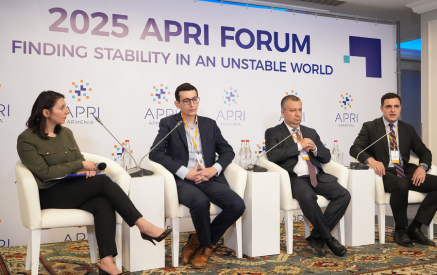by Stepan Piligian
It was not a particular concern until after the Genocide. The idea of losing identity with one’s Armenian heritage was foreign until 1915. After all, most Armenians lived as an indigenous people on their ancestral lands in the western highlands. When you live as an ethnic group in densely populated villages and cities, retaining your identity is essentially taken for granted. You were born into Armenian families, educated at Armenian schools, taught the Christian faith of our people and embraced the culture like the fabric of your clothing. The language you spoke was the mother tongue unless you were prevented from speaking Armenian by the Turkish authorities. This was the case of my maternal grandfather who was raised in the Dardanelles and learned Armenian only when he immigrated to America. The threat to our people concerned their very human existence. It was manifested by the attempt to murder a nation. They failed, but many of our ancestors became victims (now sainted); the remainder were scattered outside their native lands and became what we now refer to as the diaspora.
After that devastating period, which continued into the 1920s, the primary concern of our rebuilt nation outside of Armenia has been cultural survival. This was not the physical survival that our grandparents experienced, but an identity survival. While continuing the struggle for justice, the diaspora took on another, almost invisible force, called assimilation. The Turkish criminals were convinced that anyone who survived the Genocide and was expelled from their homeland would eventually blend in with their host nation culture and lose their ethnic Armenian identity.
Read also
They grossly underestimated the resolve of this nation to retain their soul. If the Turks had bothered to understand the Armenians, they would have discovered a history of survival that defied logic going back thousands of years. Even the concept of forced migration was not new, as the Armenians experienced a major demographic shift after the Bagratuni dynasty into the Cilician region. It was here in the land of Adana, Marash and Urfa that Armenia was reborn with the Rupenian dynasty in the 11th century and the seat of the Catholicos in Sis. Only the mass murder of the inhabitants would end their presence.
My Adanatzi grandmother actually experienced three horrific massacres as did the Armenians of Cilicia. The first was in 1909 when the Adana massacres claimed the lives of over 30,000 Armenians. My grandmother, who was about nine years old at the time, was sent to live with relatives in Egypt to avoid the atrocities. She returned and lived through the harrowing times of the Genocide, particularly from 1915-1918. After the war ended in the fall of 1918, Armenians were encouraged by the victorious allies to return to their homes in Cilicia. My grandfather was a gamavor stationed with the Armenian Legion in Adana where he met, courted and married my grandmother. They experienced the final betrayal of the “allies,” who withdrew from the region leaving the Armenian population at the mercy of the marauding nationalist Turks under Kemal. Once again, there were atrocities, and the survivors were forced to leave for Syria, Lebanon, Europe or the United States.
By the mid-1920s, the survivors were establishing communities in the United States. The priority became investing in enough infrastructure to protect the identity of those children born to the survivors. They were proud Americans but morally committed to retaining that which the Turks had chosen to destroy. Soon the churches, clubs and compatriotic unions were formed to reflect a combination of retaining the past and building for the future. This has been the mission of the diaspora for nearly 100 years and now five generations. It is a difficult task complicated by a material society, secular values and intermarriage. For those Armenian parents committed to the identity retention of their children, it is the elephant in the room. How do I teach my children to establish a connection with their faith and heritage in a world that encourages us to blend? The challenge has evolved over the decades. The first generation of children born outside the Armenian homeland was the first exposed to the host nation culture.
Their parents were survivors, and as such they retained the language in the home and straddled the line of a hyphenated life. They fought for America and retained a strong commitment to the Armenian community. Over time, it became more fashionable to be American here, and it is reflected as some Armenians chose a singularly American life. Being different was something to avoid. In succeeding decades, the winds shifted further as being unique became more popular and Armenian names and ethnic identity surged. A significant influx of immigrants, particularly from the Middle East, “reset” the assimilation clock. Despite these swings in the diaspora of the United States, the challenges remained very acute. Just as the rules changed in the 1920s with an emphasis on identity survival, another shift occurred in 1991. With the independence of Armenia, the diaspora took on the responsibility of assisting in nation building. It is actually, in my view, the greatest opportunity for the diaspora but remains underutilized.
I grew up during a time when Armenia was considered a “stateless” nation. Of course, there was the Armenian Soviet Socialist Republic, but Armenia was not an independent sovereign state. It was not in the United Nations, and its flag was a derivation of the Soviet Union. In our community, we embraced the tri-color flag, but I learned quickly that it was not accepted by a large portion of the diaspora. It was a reflection of the past from the First Republic and our hope for the future with an independent Armenian state. It was awkward to explain to my non-Armenian friends how this great nation with a history almost without peers did not have a seat at the United Nations. I will be forever grateful that my children’s generation and their children do not have to experience this dilemma as Armenia now stands proudly as a free nation with a place on the world stage. This is why we must protect sovereignty with all our capability. Only if you experience the drought, does the rain have precious value.
It is never too late to discover the beauty of your heritage.
The homeland offers Armenian parents a unique opportunity to address the fear we feel for our children. During this time of the year, we experience the renewal of spring. Likewise, it is a time to consider the numerous youth-oriented programs in Armenia. Sending your children on any number of offerings will establish an emotional connection with their heritage. Many of us have personal experiences witnessing this phenomenon. It has long been established that connecting to your heritage in the diaspora is a choice. Unlike growing up in a village in Western Armenia where the environment leaves little choice, the diaspora offers the opportunity to simply and quietly leave your heritage behind. The buildings, programs and activities we have in this country are essentially to influence that decision that each of us will make at some point in our lives. For some, it is not a conscious decision, but more of an affinity between our interests and our heritage. Others may have a latent discovery through some experience. It is never too late to discover the beauty of your heritage. These programs all focus on giving the participant a social experience with peers and service experience in the environment of their homeland. Young people want the ability to build friendships and enjoy their journey in life.
We all understand the beauty of having friends from all over the country that you meet at AYF Camp Haiastan or Camp Nubar. Imagine the impact of associating with Armenian youth from around the world together with peers from Armenia. The impact on your own personal path is remarkable. In order to connect diaspora youth to their heritage, they must find their way with an emotional experience that touches their heart. Once the emotional connection is made, the mind is open to knowledge and identity. Birthright Armenia has established a stellar reputation for individuals from 21-32 years old and has a host of options for volunteers through service and education. The AYF Youth Corps and AYF Internship offer volunteering at camps, other service programs and touring. Discover Armenia is a summer program run by the AGBU and is focused on experiencing Armenia through volunteering and service. RepatArmenia runs a number of programs such as Diaspora Youth Ambassador which combines service with personal development. The ACYOA has managed the Armenian Service Program (ASP), which offers a faith-based service experience for 18-30 year olds. The AMMA also runs summer camps where counselors and other vocational opportunities are combined with a service experience. The Paros Foundation offers Service Armenia for 17-23 year olds during the summer. They also offer a Young Professional trip in the fall. This is a small sample of the diverse and outstanding programs available.
I have had the distinct pleasure of seeing the results of these experiences. To witness young Armenians building a home or renovating a playground is a special moment. All of these young people return changed for the better. With their service contributions, they become a small but vibrant piece of the nation. They contribute to the bonding of the diaspora and the homeland. Perhaps most importantly, their personal development is rewarding. Many of them return to contribute to their local communities or contribute to the homeland in a different capacity. I remember a panel discussion I attended a few years ago featuring individuals who participated in some of these programs. One young woman in particular was a great example. She went to Armenia not having lived in an Armenian community but returned with the emotional connection described earlier and a passion to continue her journey.
Collectively, we need to ensure that these programs are subscribed to fully and that demand enables expansion. I am convinced that the best way to help your children with their identity journey is to participate in one or more of these superb programs. It will directly address the concerns we have as parents, and they will have an unprecedented experience. It is tragic when I read that some of these programs have openings that remain as such. There is no need to lament our concerns with a resource like Armenia and the diaspora programs available. The time is now for those with children as young as high school. Armenia is a very safe and welcoming country. The headlines in the diaspora are always the political problems and regional security concerns. Your children will enter a different world where the beauty of Armenia and their heritage thrives. We have the programs. We have the resources. Do we have the will?



























































